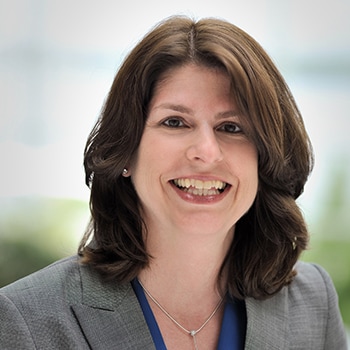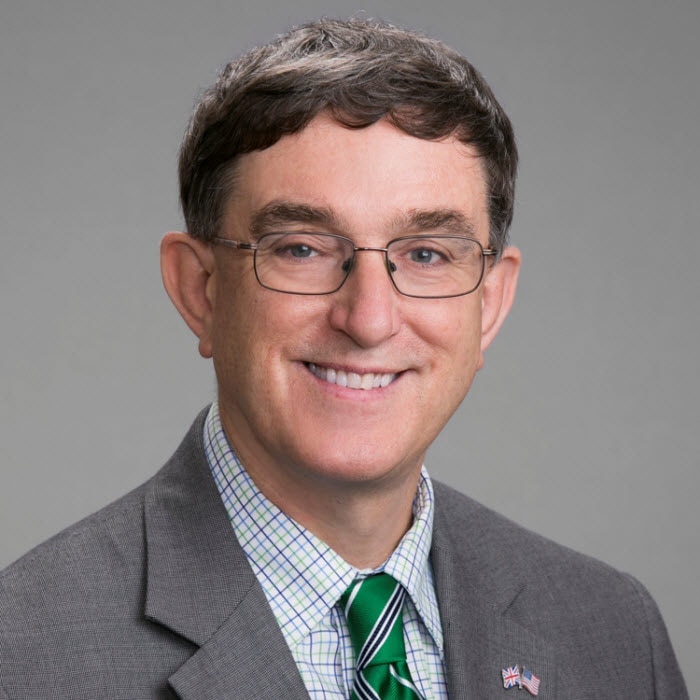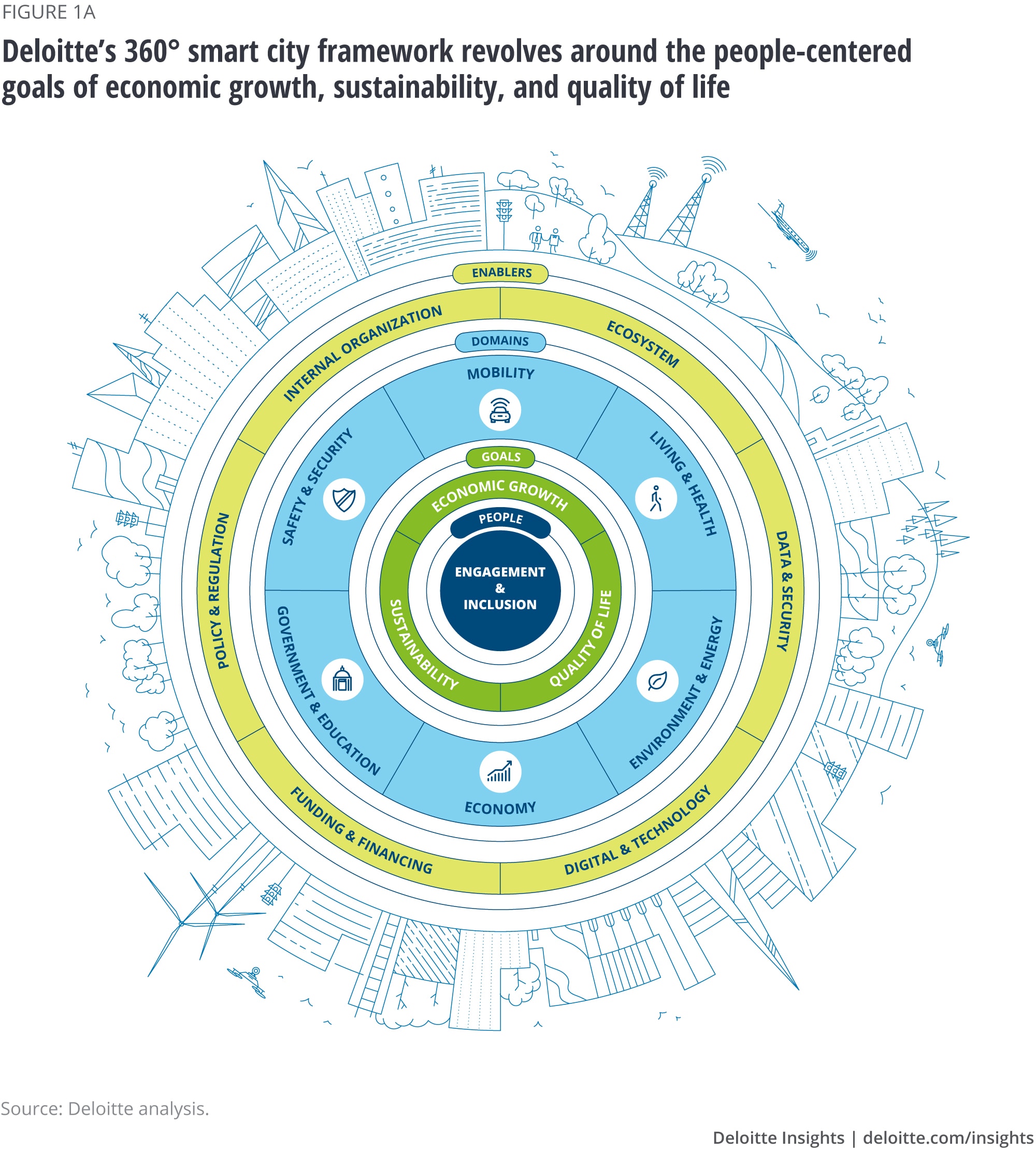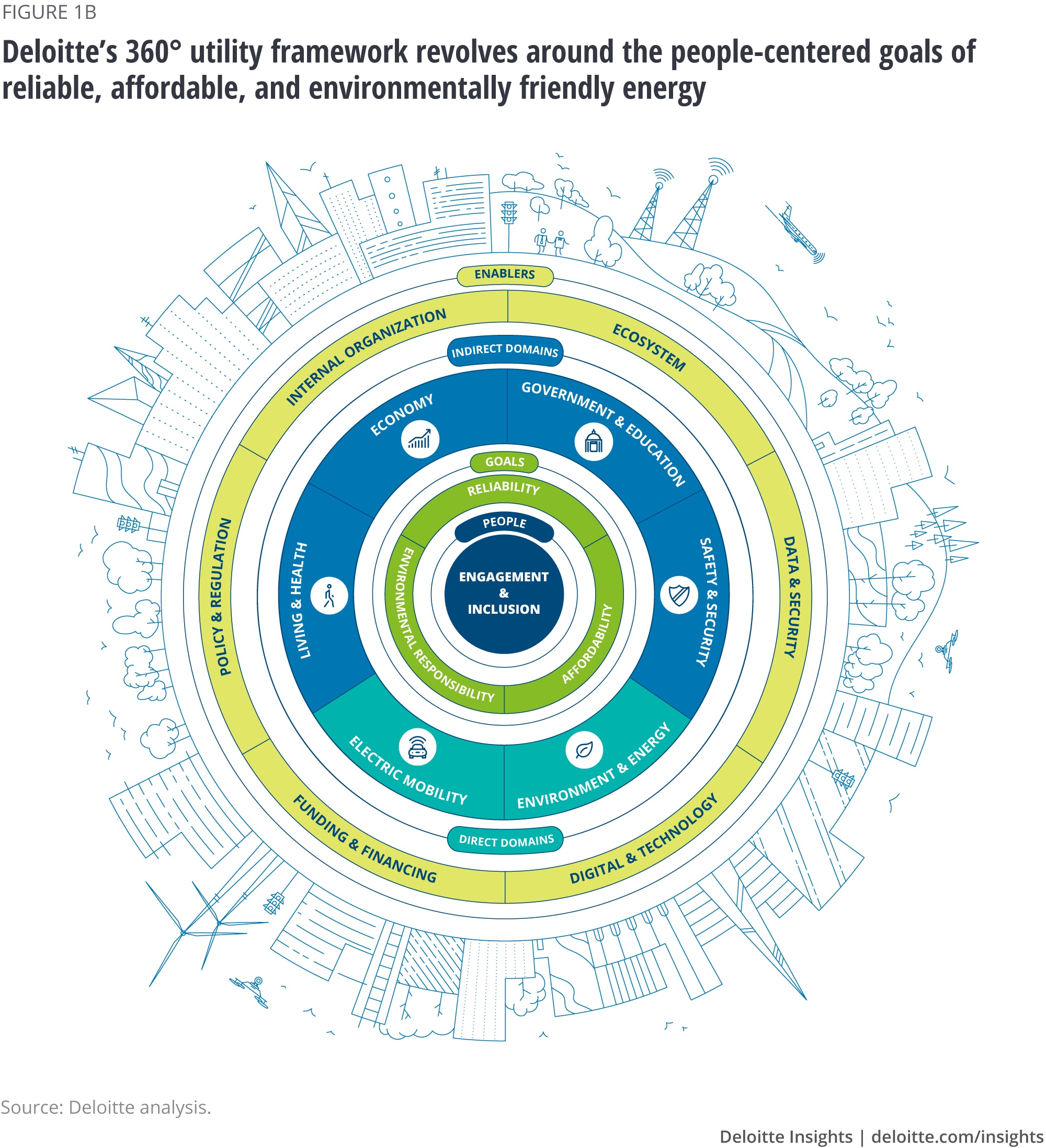
Renewables (em)power smart cities Wind and solar energy best enable the goals of people-centered smart cities
19 minute read
05 March 2019
 Marlene Motyka United States
Marlene Motyka United States Scott Smith United States
Scott Smith United States Andrew Slaughter United States
Andrew Slaughter United States Carolyn Amon United States
Carolyn Amon United States
As cities expand, so does their energy use. And as cities strive to become “smart,” renewable solar and wind power can play a crucial role in helping them achieve their goals.
Cities’ small geographical footprint belies their significance. They cover 2 percent of the world’s landmass,1 but account for most of the world’s population, economic activity, and energy use. Here, we focus on the third aspect—energy use—as cities and renewable electricity have, respectively, become the habitat and energy of choice globally. The two are increasingly inseparable. As cities vie to attract growing businesses, talent, and innovation in an increasingly global competition, solar and wind power have become key for many in achieving their smart city goals.
Learn more
Updated 2021 list of Smart Rewable Cities
View more content for the Power & Utilities sector
Subscribe to receive content related to Energy & Resources
This report discusses how renewables can empower smart cities. We will start by exploring the urbanization and electrification trends that have turned cities and the grid into leading platforms for human activity. Technology can help make these platforms smarter by providing actionable data, but technology’s greatest value lies in its people-centered deployment—that is, to the benefit of all citizens/customers. The goals of a people-centered smart city are economic growth, sustainability, and quality of life, while the goals of a utility are to provide reliable, affordable, and environmentally responsible energy. Solar and wind power are the linchpins to aligning and achieving both sets of goals. To better describe cities that recognize this and harness wind and solar energy, we developed the concept of smart renewable cities (SRCs). SRCs are already powered by solar and wind and envision the further deployment of these sources as integral to their smart city plans.
We will discuss each of the aforementioned smart city goals from an SRC perspective, with an emphasis on utilities’ role. First, SRCs can foster economic growth because renewables are competitive with conventional sources and conducive to job creation and innovation. Second, SRCs can promote sustainability through renewable-powered buildings and electric mobility. Third, SRCs tend to offer a higher quality of life by being inclusive, healthier, and empowering places to live. Finally, we will show how SRCs implement their initiatives through an ecosystem of stakeholders, chief among which are utilities.
The intersecting platforms of cities and utilities
Cities and utilities provide leading, growing, and transforming platforms for human activity. Cities form the leading habitat platform for human activity and utilities’ electric grids form the leading energy platform. Most of the world’s population lives in electrified urban centers; areas where this is less the case are seeing some of the fastest growth in urbanization and electrification rates. Accounting for 70 percent of global energy use, cities are utilities’ leading growth territory.2 City and utility platforms are sometimes contiguous and sometimes overlapping in their geographies and assets. For example, municipal utilities fall within their cities’ remit, while investor-owned utilities may not; streetlights may be city-owned or utility-owned. The current and potential growth of both platforms is enormous as cities interlink to form megalopolises and grow into megacities (that have 10 million or more people), and as electrification spreads to new sectors such as transportation. As these platforms expand, their boundaries are blurring: Where does a city end and the suburbs begin? Where does the utility’s jurisdiction end and that of other power and service providers begin? In both cases, how should the two relate? And who are the stakeholders? Cities’ and utilities’ boundaries of possibility are also transforming as legacy infrastructure is outfitted with connected technology. The importance and complexity of city and utility roles have grown alongside the imperative to be “smart.”
From data-driven insights to people-focused strategies
Smart city journeys progress beyond technology deployment to people-centered focus. The first stage of the smart city journey involves integrating Internet of Things (IoT) technologies, such as sensors, with existing infrastructure to create actionable data. A phase of experimentation with pilot initiatives might follow. In some cases, technologies and collected data might not ultimately prove to be useful or actionable. More advanced smart cities and utilities start consolidating experiences gained from their pilots to deploy technology in the service of people-centered strategies.3
Cities and utilities serve the same people and organizations within the city, whether as citizens or customers. Therefore, in addition to smartening their grids, utilities can leverage their infrastructure to serve smart city initiatives in areas outside of energy, avoiding costly duplication. For example, a utility’s smart meters can be harnessed to detect water leaks; smart transformers can host air quality sensors; and smart streetlights can be augmented with charging stations, video cameras, Wi-Fi, and sensors to collect data on anything from vehicular and pedestrian traffic patterns to parking spot availability. Utilities also have a connection to virtually every home and business, to which they can extend smart city initiatives via smart home systems. Thus, utilities can help serve people-centered smart city goals across the energy, economy, mobility, health, government, and safety domains.
Deloitte’s 360-degree smart city framework is designed to provide a comprehensive view of a people-centered smart city’s three cross-sectoral goals—economic growth, sustainability, and quality of life—and their enablers (see figure 1a). A mirror framework can be applied to utilities, which directly share two smart city domains: environment/energy and mobility. Utilities can also indirectly serve the other domains in the pursuit of their goals to provide reliable and affordable electricity from environmentally responsible sources (see figure 1b).


Renewables: The linchpin of smart city and utility goals
Smart cities and utilities share an interest in deploying two energy sources that align with their goals: solar and wind. Utilities are embracing wind and solar power as they reach price and performance parity with conventional energy sources across the world, help to cost-effectively balance the grid, and become more valuable assets thanks to increasingly cost-effective storage and other new technologies (see Global renewable energy trends).4 These renewable energy sources now come closest to meeting the growing demand for reliable, affordable, and environmentally responsible energy sources that utilities seek to provide. As a result, renewables have become the preferred energy sources for key consumers such as cities. Another key consumer that is valuable to both cities and utilities is corporations, which procured record amounts of renewables in 2018.5 Unlike most energy sources, wind and especially solar power can be deployed in and by the city itself. Finally, solar and wind power are citizen/customer-centered energy sources because many residents and businesses are demanding these renewables and are increasingly empowered to deploy them on their own properties and buildings, or purchase shares of solar and wind projects or power through community energy initiatives.
The Biggest, Purest, and Newest smart renewable cities
SRCs recognize that solar and wind resources play a key role in powering smart city plans. Deloitte developed the SRC framework to identify and classify cities globally that are deploying solar and/or wind power in connection with their smart city plans. SRCs are the vanguard, charting a course that all smart cities are expected to pursue as they advance toward people-centered goals. With solar and wind already a part of their energy mix, and a pipeline for more, SRCs are strategically positioned to leverage their shared interest in renewables with utilities to more quickly achieve these goals. Deloitte’s SRC model considers the Biggest, Purest, and Newest SRCs to showcase the range of initiatives that are being implemented or considered, and the range of roles that utilities can play in initiating, shaping, or participating in them in conjunction with other service and technology providers (figure 2). Smart city plans are typically associated with the Biggest cities, which tend to be replete with legacy infrastructure and complexity, and face some of the greatest challenges and opportunities across all areas. Meanwhile, the Purest cities show what initiatives can bring cities closest to being entirely powered by solar and wind. Finally, the Newest greenfield projects demonstrate what a fully intentional and unhindered deployment of SRC initiatives can potentially accomplish at various scales. Looking at the challenges and successes of the cities in each of these categories can help other cities and utilities determine their strategies.
More specifically, SRCs can be defined as cities with a vision that integrates renewables and smart initiatives. To qualify as an SRC, the Deloitte model requires that cities have a publicly available city plan that presents a vision (see sidebar, “SRC visions integrate renewables and smart city initiatives”). In addition, it must have already deployed solar and/or wind power (at least 1 percent of its city energy mix) and plan to deploy more. If the current solar/wind power share of the energy mix is less than 10 percent, the city must also have a renewable energy or decarbonization target (note that some of these targets may involve renewables other than wind and solar, and in the case of decarbonization targets, nonrenewable energy sources such as nuclear power).
SRC visions integrate renewables and smart city initiatives
SRC visions run the gamut from smart city plans that include renewables to 100 percent-renewable city plans that include smart city initiatives.
“The objective of the [Smart City San Diego] collaboration is to improve the region's energy independence, to empower consumers to use electric vehicles, to reduce greenhouse gas emissions, and to encourage economic growth.”6
“Peña Station Next [is] a smart city and community focused on mobility, clean energy, and more.”7
“ProjectZero is the vision for making Sonderborg ZEROcarbon by 2029, creating sustainable growth and new green jobs along the road—based on ambitious carbon reduction goals and new Bright Green Business solutions. Our vision is a powerful innovation engine for new solutions and business concepts. The innovation engine will show the future use of energy, food, water, and other resources. We strive to create market-driven concepts benefitting citizens and businesses. We do this by developing new solutions and collaborative partnerships based on smart climate solutions.”8
Figure 2 presents three types of SRCs. First, the Biggest SRCs comprise all the cities that qualify as SRCs and have over a million residents (and many more nonresidents served). The highest share of solar and wind power recorded among the Biggest SRCs is in Adelaide, Australia (42.2 percent of the energy mix). The list of the Purest SRCs picks up where the Biggest SRCs leave off: It includes all the cities, regardless of size, where solar and/or wind account for over 42.2% of the current energy mix. Finally, the Newest SRCs are greenfield smart city projects entirely powered with renewables.

Takeaway: SRCs are geographically diverse
While people-centered smart cities are associated with developed countries, our Biggest, Purest, and Greenfield SRC categories all include cities in emerging markets. In fact, these countries have some of the most ambitious plans: to build multimillion-people, 100 percent renewable SRCs from scratch. This is significant because renewables are often more cost-effective than conventional generation, and their deployment is most imperative in emerging markets, where cities and energy demand are most rapidly growing.
Applying Deloitte’s 360-degree framework to the Biggest, Purest, and Greenfield SRCs involves identifying how the deployment of renewables contributes to smart city goals (see figure 3). The next three sections will discuss each goal from an SRC perspective, with an emphasis on utilities’ role in SRCs’ initiatives.

Green economic growth
SRCs foster economic growth because renewables are competitive and conducive to job creation and innovation
Promote sustainable economic growth with the help of affordable and reliable renewable power. In the world’s top solar and wind markets, where most of our listed SRCs are located, solar and wind have reached price parity with conventional sources.11 Utilities may find that integrating renewables into a city’s energy mix is cheaper than constructing new or operating existing conventional generation, yielding lower electricity rates.12 The purest of the Pure SRCs, Georgetown, saw its electricity prices decrease from 11.4c/kWh in 2008 to 8.5c/kWh after reaching its 100 percent wind and solar goal in 2017.13 The city’s municipal utility embraced the renewables target on the grounds it would save on electricity costs, decrease water usage, and reduce fuel price and regulatory risk.14 The additional reliability stems from the 25-year term of the renewable power purchase agreement (PPA), versus a maximum of seven years for natural gas. Georgetown also benefited from the complementarity of solar and wind resources, reducing the need for storage.
Attract and retain companies procuring renewables and providing green jobs. Georgetown’s existing business community can leverage the town’s “100 percent renewable” status, which is also attractive to Fortune 500 companies and members of RE100, a growing group of 165 companies (as of February 2019) committed to achieving and/or maintaining 100 percent renewable use.15 Many of these companies offer the high-paying jobs that cities seek. In fact, some companies expressed interest in relocating to Georgetown as soon as the city announced its renewable energy plans.16 Another source of job creation is the deployment of renewables themselves. At a time when many cities are offering fewer of the better kinds of jobs and wages they have traditionally offered lower-skilled workers, renewable installations and operations and maintenance are an attractive local job-creation opportunity.17 Thus, the rooftop solar capital San Diego is framing its 100 percent renewables target as a “job creator.”18
Encourage entrepreneurship and innovation via renewable business incubators. Next, as frontrunners in the deployment of renewables, some SRCs have positioned themselves as renewable incubators. San Diego promotes itself as “a global leader in microgrid technology,” with renewable microgrids deployed at its state university campus, military bases, and port.19 Some of these projects involve partnerships with utilities to test how microgrids can provide grid reliability and renewable-energy-firming services to the central grid.20 Another example is SRC Nelson Mandela Bay, which has positioned itself as the South African and continental “hotspot for ‘green’ energy” manufacturing.21 In direct partnership with the private sector, Nelson Mandela Metropolitan University hosts an incubator—Propella—that focuses on renewables and is actively involved in the development of Nelson Mandela Bay’s emerging smart city plan.22 Meanwhile, greenfield SRC Peña Station Next is an incubator for SRCs in general, as “a regional, national, and global showcase for innovation districts, setting the standard for smart, sustainable, connected living.”23 Utility Xcel Energy operates Peña Station Next’s advanced renewable microgrid and is working with the locally based National Renewable Energy Laboratory on creating the largest net-zero energy community in the United States.24 More specifically, Xcel Energy is seeking to demonstrate how a multistakeholder, solar-plus-storage microgrid can support the grid in five different use cases: renewable integration through ramp control and time shifting, peak demand reduction, arbitrage, frequency regulation, and backup power.25
Sustainable buildings and transportation
SRCs can promote sustainability through renewable-powered buildings and electric mobility
The two sectors accounting for most of the energy use in our listed SRCs are buildings and transportation. While energy efficiency is key to reducing this use, renewables are ushering a paradigm shift in how these sectors are powered and how they relate to utilities.
Manage energy and natural resources wisely through smart renewable-powered buildings, recycle and reuse assets by pursuing nonwire alternatives to building new power plants, and reduce carbon footprint through zero-emissions energy. Equipping smart buildings26 with solar panels and/or micro wind turbines, potentially with energy storage, creates distributed energy resources (DER) that can be used for self-generation but can also potentially feed power into a microgrid or central grid. Utilities are indispensable to two-way communication between DER and the grid. San Diego Gas & Electric (SDG&E) is involved in its city’s smart building initiatives. It has deployed smart meters and worked with IoT technology providers to give building operators demand-response capability: Energy consumption sensors relay use patterns, enabling cost-saving behavioral adjustment.27 In another San Diego smart city project, pursued in partnership with a real estate company, SDG&E deployed virtual net metering displays and smart thermostats in an all-solar, net-zero, smart living community.28 In SRC Georgetown, Georgetown Utility Services (GUS) has taken a step further as the municipality pursues a new goal of producing its renewable power locally. GUS has proposed installing solar panels on leased residential rooftops connected to storage batteries, framing the initiative as a nonwire alternative to building a utility-scale power plant. The benefit to GUS is ensuring deployment across the city that maximizes the capture of solar resources and their value to the grid, as well as operating the distributed solar and storage as a virtual power plant. Meanwhile, residents do not need to invest in the cost of installing a solar-plus-storage system but can benefit from its use as a backup power source.29 Finally, AGL Energy, the utility serving SRC Adelaide, is already harnessing locally produced renewables in its deployment of the world’s largest residential virtual power plant. Through the aggregation of 1,000 solar-plus-storage systems, AGL Energy plans to provide both 5MW of energy and services to the grid.30 In this case, homeowners with solar power purchase a subsidized battery and receive a feed-in tariff for energy discharged to the grid.31
Drive toward cleaner air and reduced noise by deploying renewable distributed energy resources and clean mobility. A similar dynamic plays out in renewable electric mobility. All-electric transportation modes open the opportunity for the integration of renewables, from wind power purchases to run a transit system on 100 percent renewables (for example, SRC Calgary) and rooftop solar installations to entirely power metro stations (for instance, SRC Jaipur), to the deployment of solar-plus-storage-powered electric vehicle (EV) charging stations that can also power the surrounding community.32 The latter case—a San Diego smart city initiative that SDG&E manages—points to where perhaps the most opportunities for utilities lie. In some cities, the city and/or third parties are installing EV charging stations without consideration for grid impact. At the other end of the spectrum, utilities are involved in pilots to strategically deploy them as grid-enhancing DER.
The next step in this process is to establish three-way communication between the utility, customers, and vehicles. Here the utility’s role is to enable a shift in EV charging to times when excess renewable power is available on the grid and enable EV batteries to discharge power back to the grid to help meet peak power needs. The utility can more effectively support the build-out and integration of charging infrastructure in such cases. The automotive industry may also become a key stakeholder in this process. In Japan, utility Chubu Electric Power Company is working with Toyota Tsusho Corporation and vehicle-to-grid (V2G) platform developer Nuvve to test the grid impact of deploying bi-directional charging stations. In a nascent form of partnership, utilities and automakers are also jointly creating platforms for customers to select charging times based on preference, renewable generation, and electricity price.33
Looking ahead, a groundbreaking electrified road opened in Sweden last year suggests an alternative pathway for smart electric mobility, with potentially significant implications for utilities.34 Given the limitations to charging station rollouts in dense urban environments and the friction involved in physically plugging in vehicles, electrified parking spots and roadways allowing for continuous inductive EV charging may eventually become the preferred infrastructural investment in cities, with roadways forming a new renewable electric mobility platform for utilities to explore.
Takeaway: Utility involvement is key to ensuring that SRC initiatives strengthen rather than burden the grid
As renewable electrification spreads to buildings, vehicles, and even roads, new sources of electricity demand and supply are buffeting the grid. Whether utilities have visibility into this activity—let alone the ability to shape it and derive new revenue streams from it—depends partly on their level of involvement and communication with other stakeholders, including prosumers and automakers. Proactive utilities are incentivizing strategic location of DER, aggregating them into virtual power plants, and harnessing them to help balance the grid.
Higher quality of life for all
SRCs can offer a higher quality of life by being inclusive, healthier, and empowering places to live
Foster inclusivity by providing lower-income households access to renewables. “Green” initiatives are sometimes erroneously equated with elitism, undermining their adoption. There are concerns about a growing green gap between affluent households, among which solar panel and EV ownership remains concentrated, and the rest left to shoulder the costs of legacy energy systems. In response, many SRCs have launched initiatives to expand access.35 While net metering has fueled rooftop solar booms among less affluent populations in SRC Bangalore, many utilities are ambivalent about the impact to their bottom lines. Other SRCs such as Adelaide have implemented initiatives to lower upfront costs for solar systems.36 The previously discussed GUS model, developed on the basis of citizen feedback, democratizes access because the utility covers panel installation, maintenance, and insurance costs in exchange for leased residential rooftop space to host a solar-plus-storage system that it owns and operates.
Safety through emission-free city centers. Inclusivity is built into greenfield SRCs to the extent that renewables and electric mobility are integrated throughout the city from the outset. This also allows greenfield SRCs to minimize most local air pollutants in a world where 80 percent of urban dwellers are exposed to pollution levels exceeding World Health Organizations limits for public safety.37 The percentage rises to 98 percent in low- and mid-income countries, magnifying the quality-of-life appeal of emerging SRCs Xiongan and Neom. A growing trend among SRCs is to further improve air quality by restricting vehicular access to their city centers. SRC Copenhagen has banned diesel cars from the city and introduced car-free areas; SRC London’s ultra-low emission zone will come into effect in April 2019; and SRC Paris announced a ban on internal combustion engines (ICE) by 2030. Some state and national policies align with these efforts. California’s target for 100 percent zero-emission-vehicle sales by 2050 will affect SRCs San Diego and Los Angeles and is expected to have a national impact, as so many California policies do; India’s ICE sales ban targeted for 2030 covers SRCs Bangalore and Jaipur; and the United Kingdom’s ICE sales ban by 2040 covers SRCs Birmingham, London, and Manchester. Germany is also considering an ICE sales ban that would affect SRC Hamburg. The cities’ proposed restrictions are part of larger SRC efforts to encourage greater use of public transportation within the city while discouraging personal vehicle use. City center vehicular access may eventually be limited to fleets of autonomous EVs—an idea that SRC Peña Station Next is piloting with its autonomous EV shuttle fleet, although these efforts may be further out than many have predicted.38 As a result, the number of commuter EVs and mobility service provider EV fleets parked on the outskirts of cities will likely significantly grow, opening another opportunity for utilities to capitalize on the aggregation of EV storage capacity to further help integrate renewables and balance the grid.
Enable constituent engagement via renewable prosumers. This brings us back to the point that integrating renewables into the building and transportation sectors opens the prospect of transforming building operators and EV owners into energy consumers and producers—or prosumers. The utility mediating this relationship determines the extent of prosumer empowerment. Danish utilities are a leading example in this regard. By 2020, smart meters allowing for hourly billing are to be fully deployed to facilitate more granular pricing and demand response in SRCs Copenhagen and Sonderborg.39 While Washington, DC and seven US states have smart meter penetration rates above 80 percent, according to the EIA’s latest Residential Energy Consumption Survey, only 4 percent of households have accessed hourly or daily data, pointing to regulatory lag in the approval of time-of-use rates, and to significant untapped prosumer potential.40
Understanding a smart renewable city’s enabling ecosystem
SRCs implement their initiatives through an ecosystem of stakeholders, chief among which are utilities
The ecosystems in leading SRC examples—San Diego, Georgetown, and Peña Station Next—are city-led in the sense that these cities and founding stakeholders created a smart city vision and set targets that are more ambitious than their respective regions, states and/or countries. A strong local network propels them. In the case of a big SRC such as San Diego, this network involves several overlapping platforms that include the utility among many partners across a range of industries. For example, SDG&E is a founding member of Smart City San Diego, a public-private collaboration between the city, the utility, General Electric, the University of California, and CleanTech San Diego.41 SDG&E is also involved in smart city initiatives through its membership in the latter, a nonprofit that brings together 43 energy and technology companies, six academic institutions, 14 government entities, 15 community partners, seven business and financial actors, three building and construction groups, and 14 professional services firms. In nationally led SRCs Bangalore and Jaipur, the Indian government initiated the development of SRCs by providing a framework and platform, allocating funding, and centrally monitoring deployment; while utilities play a role, they are more reactive than proactive. European cities account for almost a third of our SRCs partly due to the European Union (EU) serving as an additional supranational driver: The EU has deployed dozens of smart city projects, initiatives, and networks, as well as funding, to support smart cities and utilities. Finally, a unique alignment of supranational, national, city, and intercity drivers explain why Danish cities account for two of the Purest SRCs.
Municipal and investor-owned utilities (IOUs) have played different roles in accelerating the adoption of renewables across the SRC categories. Thus far, most of the Purest SRCs have a municipal utility element, and some of the Biggest SRCs have also used them to achieve their renewable targets. SRC Hamburg’s citizens pushed for a successful referendum to remunicipalize their utility in the name of “democratically controlled energy supply from renewable energy.”42 Meanwhile, IOUs are leading innovative smart city initiatives in the Biggest and Newest SRCs San Diego and Peña Station Next. While municipal utilities generally have fewer resources and fewer advantages, due in part to scale, than their investor-owned counterparts, and must assume credit and finance risks, they have the potential to quickly implement ambitious renewable goals aligned with citizen demands. SRC Georgetown was able to achieve its 100 percent renewables target in a matter of years and has secured a US$1 million US Mayors Challenge grant from Bloomberg Philanthropies to help achieve its next target of creating a virtual power plant with locally produced renewables. By contrast, while SDG&E is a key stakeholder in Smart City San Diego and a leader in renewable energy and many aspects of smart cities, the city is turning to community choice aggregation (CCA) to create a pathway to its 100 percent renewables target. At the same time, SDG&E is rethinking its business model and is potentially exploring exiting the electricity procurement role to focus on delivery.43 Peña Station Next’s partner utility Xcel Energy has taken a different tack. In alignment with SRC goals, it is the first IOU to commit to 100 percent carbon-free electricity by 2050.44
Takeaway: SRCS with aligned stakeholders are most quickly and effectively reaching their goals
SRCs’ ecosystem of stakeholders is most enabling when: 1) the city, regional, national, and supranational levels are aligned in driving SRC initiatives; 2) the SRC’s goals align with those of its utility either because the latter is a municipal utility, or an investor-owned utility embracing renewables; 3) the SRC has a platform to bring together its multiple stakeholders, including the city, utility, technology providers, builders, research/academic institutions, and citizens.
Conclusion
Smart cities have a growing opportunity and imperative to become SRCs. The integration of more solar and wind power into city energy mixes can directly power their goals to be more economically competitive, sustainable, and livable. In fact, these goals cannot be achieved without a significant share of renewables. Utilities play a key role in their successful deployment as electrification powered by both utility-scale and distributed renewable energy spreads in the building and transportation sectors, unlocking new possibilities for customer engagement. The Purest SRCs have already flipped the equation, presenting smart cities as a component of their renewable energy plans, recognizing that renewable power is a starting point for smart cities. It behooves both cities and utilities to be bold in their SRC journeys, as growth is not guaranteed. Cities are competing with one another, while utilities may risk losing business and other opportunities to nontraditional electricity providers. The first cities and utilities to achieve 100 percent renewables may reap the most reward as they attract a growing number of like-minded stakeholders.
More insights for Power & Utilities
-
The carbon-neutral utility Article6 years ago
-
The power is on: How IoT technology is driving energy innovation Article8 years ago
-
Powering the future of mobility Article6 years ago
-
Powered by blockchain Article5 years ago
-
From bytes to barrels Article6 years ago













